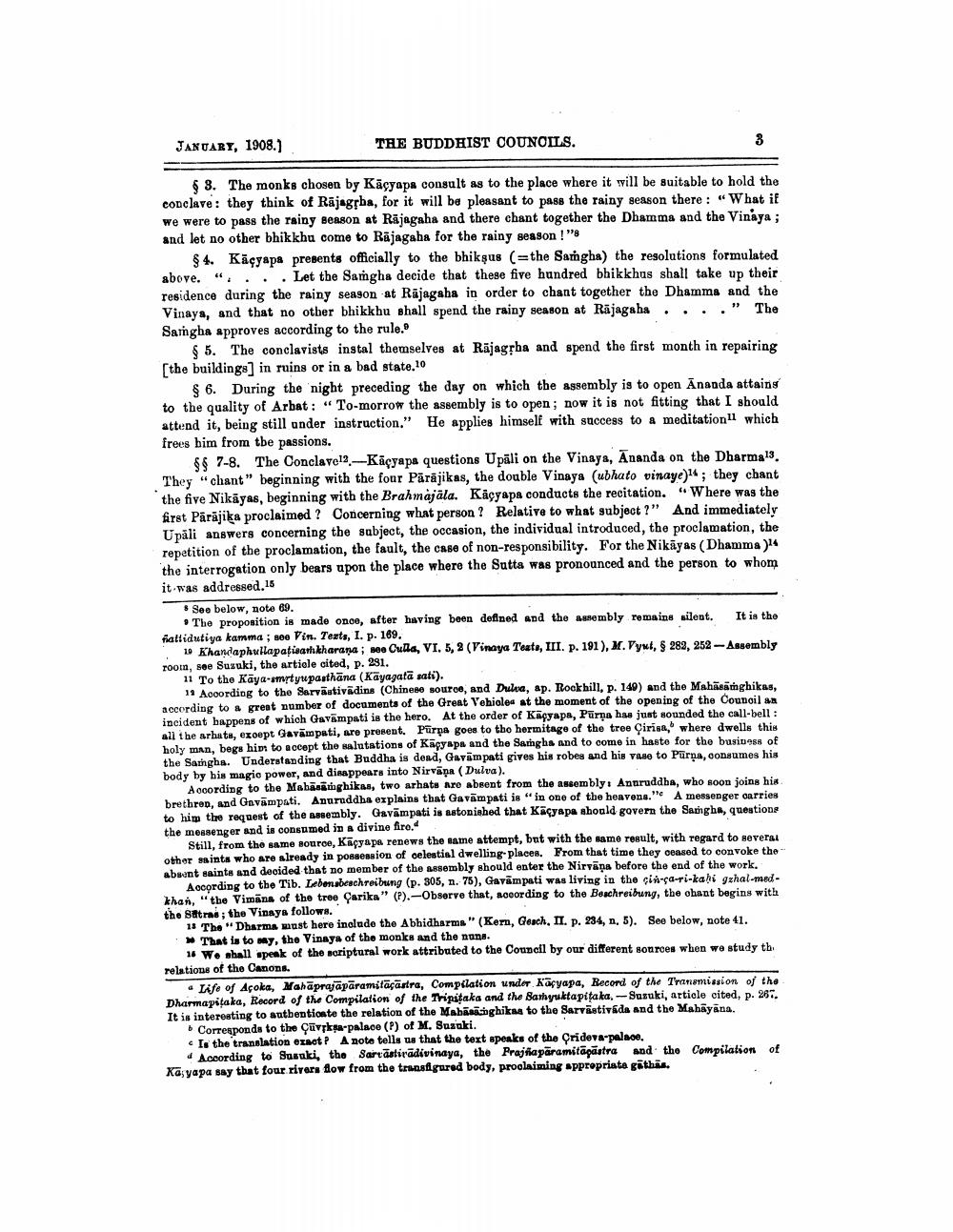________________
JANUARY, 1908.)
THE BUDDHIST COUNCILS.
$ 3. The monks chosen by Kāçyapa consult as to the place where it will be suitable to hold the conclave: they think of Rājagęba, for it will be pleasant to pass the rainy season there : "What if we were to pass the rainy season at Rajagaha and there chant together the Dhamma and the Vinaya; and let no other bhikkhu come to Rājagaha for the rainy season!"
$ 4. Kāçyapa presents officially to the bhikṣus (=the Samgha) the resolutions formulated above." ... Let the Samgha decide that these five hundred bhikkhus shall take up their residence during the rainy season at Rajagaha in order to chant together the Dhamma and the Vinays, and that no other bhikkhu shall spend the rainy season at Rājagaha...." The Sangha approves according to the rule.
$5. The conclavists instal themselves at Rājagpha and spend the first month in repairing [the buildings] in ruins or in a bad state.10
$ 6. During the night preceding the day on which the assembly is to open Ananda attaing to the quality of Arbat: “To-morrow the assembly is to open; now it is not fitting that I should attend it, being still under instruction." He applies himself with success to a meditation which frees him from the passions.
$$ 7-8. The Conclave! Kaçyapa questions Upāli on the Vinaya, Ananda on the Dharma 13. They "chant" beginning with the four Pārājikas, the double Vinaya (ubhato vinaye) ; they chant the five Nikāyas, beginning with the Brahmajala. Kaçyapa conducts the recitation. “Where was the first Pārājika proclaimed ? Concerning what person? Relative to what subject ?" And immediately Upāli answers concerning the subject, the occasion, the individual introduced, the proclamation, the repetition of the proclamation, the fault, the case of non-responsibility. For the Nikāyas (Dhamma) the interrogation only bears upon the place where the Sutta was pronounced and the person to whom it was addressed. 15
See below, note 69.
9 The proposition is made once, after having been defined and the assembly remains silent. It is the fallidutiya kamma; seo Vin. Tezts, I. p. 169.
10 Khandaphullapaian kharana; no Culla, VI. 5, 2 (Vinaya Teats, III. p. 191), . Vyut, $ 282, 252-Assembly room, see Suzuki, the article cited, p. 291.
11 To the Kāya-smrtyupasthāna (Kayagatā sati).
11 According to the Sarvästivādina (Chinese source, and Dulva, ap. Rockhill, p. 149) and the Mahasanghikas, according to a great number of documents of the Great Vehicles at the moment of the opening of the Council an incident happens of which Gavāmpati is the hero. At the order of Kayapa, Purns has just sounded the call.bell : all the arhats, except Gavāmpati, are present. Purpa goes to the hermitage of the tree Çirisa, where dwells this holy man, begs him to accept the salutations of Kaçyapa and the Samghs and to come in haste for the business of the Samghs. Understanding that Buddha is dead, Gavāmpati gives his robes and his viso to Purņa, consumes his body by his magic power, and disappears into Nirvana (Dulva).
According to the Mahasanghikas, two arhata are absent from the assembly: Anuruddha, who soon joins his brethren and Gavampati. Anuruddbs explains that Garampati is "in one of the heavens." A messenger carries to him the request of the assembly. Gavāmpati is astonished that Kaçyapa should govern the Samgha, questions the messenger and is consumed in a divine firo.
Still, from the same source, Kaçyapa renews the same attempt, but with the same result, with regard to several other saints who are already in possession of celestial dwelling places. From that time they ceased to convoke the bent saints and decided that no member of the assembly should enter the Nirvana before the end of the work. According to the Tib. Lebensbeschreibung (p. 305, n. 75), Gavampati was living in the cin-sa-ti-kaki gzhal-med
Vimans of the tree Garika" (?).-Observe that, according to the Beschreibung, the chant begins with the Stras; the Vinaya followe.
15 The Dharma must here include the Abhidharms" (Kern, Geach. II. p. 234, n. 5). See below, note 41.
That is to my, the Vinaya of the monks and the nuns.
16 We shall speak of the scriptural work attributed to the Council by our different sonroes when we study th relations of the Canons.
. Life of Açoka, Mahaprajāpāramitācastra, Compilation under Kāçyapa, Record of the Transmission of the Dharmapitaka, Record of the Compilation of the Tripitaka and the Samyuktapitaka. - Susuki, article cited, p. 28T. It is interesting to authentionte the relation of the Mahasaighika to the Sarvästiváds and the Mahayana. • Corresponds to the çüvęksa-palace (P) of M. Suzuki.
Is the translation exact P A noto tells us that the text speaks of the Prideva palace,
According to Susuki, the Sartāstiradivinaya, the Prajfiaparamitāpāstra and the Compilation of Kaj yapa say that four rivers flow from the transfigured body, proclaiming appropriate gåthis.




